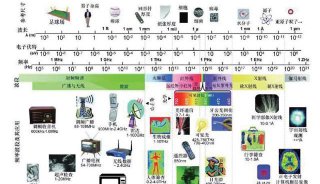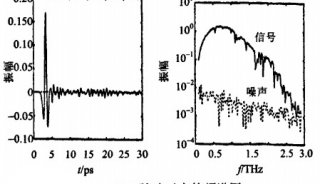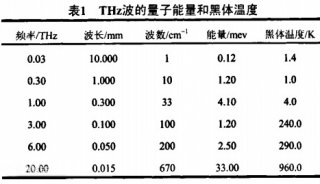太赫兹信号源Terahertz sources(一)
1. Introduction
1.1. Terahertz bibliometrics
Before turning to the topic of terahertz sources, a brief survey of the growth of the terahertz field as a whole will be made from a bibliometric perspective.
1.1.1. Terahertz outputs have grown exponentially.
For decades the field of terahertz science and technology has grown exponentially. Literally. Figure 1displays the number of documents published in the years 1975–2013 that contain 'terahertz' in the abstract, title or keyword field [1]. Figure 1(a) is a linear-linear display and figure 1(b) is a log-linear display of the same data. The data from 1975 to 2010 (inclusive) have been fitted with an equation for exponential growth,

Here D is the number of documents, D0 = 0 is the base number of documents, Y is the year, Y0 = 1975 is the base year, α = 1.55 ± 0.42 is the initial rate—meaning approximately one or two documents per year to begin with—and τ = 4.66 ± 0.18 is the time constant—meaning an increase by a factor of e approximately every five years. This time constant implies that the annual output of documents doubles approximately every three years (precisely, every 3.23 years). A simple and memorable model of one document in 1975 and the annual production doubling every three years,

furnishes a reasonable approximation to the output of terahertz literature between 1975 and 2013, as indicated by the crosses in figure 1(b).

Figure 1. Number of documents with 'terahertz' appearing in the abstract, title or keyword field as a function of time. (a) Linear-linear scale. The full line is given by y = 1.55 exp[(x − 1975)/4.66]. (b) Log-linear scale. The crosses correspond to a starting value of 1 in 1975, doubling every third year.
1.1.2. The most-cited articles concern technology.
In each of the last three full years (2011, 2012 and 2013), more than 3000 documents have appeared with 'terahertz' in either their title or abstract or as a keyword. The most-cited documents involve terahertz technology. For example, the articles 'Terahertz semiconductor-heterostructure laser' [2], 'Cutting-edge terahertz technology' [3], 'Terahertz technology' [4] and 'Materials for terahertz science and technology' [5] have each been cited more than 1000 times.
1.1.3. Monographs are now emerging.
The field has sufficiently matured such that monographs are now appearing. At first, these were edited works, with contributions from numerous authors, on topics such as terahertz sensing [6], terahertz optoelectronics [7] and terahertz spectroscopy [8]. As the field matures further, more cohesive books are appearing, with only two or three authors [9–11] and, at last, sole authors [12, 13], on topics such as terahertz excitations [9], terahertz photonics [10], terahertz techniques [11], terahertz principles [12] and terahertz physics [13].
1.2. Terahertz apparatus
A typical terahertz experimental station, such as a developed for imaging [14], tomography [15] or spectroscopy [16], comprises the three principal parts of the source, which produces the terahertz radiation, the components, which manipulate the radiation, and the detector, which senses the radiation. Practical arrangements may contain multiple sources, components and detectors (figure 2).

Figure 2. Typical terahertz apparatus. (a) Source/s. (b) Components. (c) Detector/s. (d) Applications, such as spectroscopy and imaging.
1.2.1. Terahertz sources.
The focus of this article is on terahertz sources, which will be discussed in greater detail shortly (section 2). To give some context for the discussion of sources, a few brief remarks will be made first about terahertz components and detectors.
1.2.2. Terahertz components.
Optical components are such things as mirrors, lenses and polarizers.
In contrast to visible optical systems, where lenses and similar transmitting elements predominate, terahertz systems tend to employ reflecting elements, which have minimal loss and no dispersion. Terahertz mirrors have conventionally been made of metal. Other materials have been recently trialled, for example, doped and undoped GaAs [17] and a hybrid of polypropylene and high-resistivity silicon [18]. Tunable mirrors, based on one-dimensional photonic crystals, have also been developed [19–22].
Lenses are typically made of plastics. It is advantageous if the lens transmits visible radiation, as this facilitates optical alignment. Traditionally, plastic terahertz lenses were made by machining on a lathe. Recently, lenses have been manufactured by compressing various micropowders in metal moulds using a tabletop hydraulic press [23]. Lenses with an adjustable focal length have been realized by introducing medical white oil into the lens cavity [24]. Less conventional lens designs include grooved-dielectric Fresnel zone plates, thin and lightweight [25]; plasmonic-resonance lenses, fabricated from 100 nm gold foil on a 500 µm silicon wafer [26]; and even lenses made from paper [27].
A precise method of fabricating terahertz optical components is femtosecond laser machining of LiNbO3 single crystals [28]. Diffractive elements, cavities and waveguides have been so constructed. On the other hand, temporary, or reconfigurable, components may be formed by optical modulation, using visible light projected onto a silicon chip; aperture arrays and polarizers have been made in this manner [29].
1.2.3. Terahertz detectors.
The earliest terahertz detectors were based on a thermometric property of a material, such as a change in electrical resistance with temperature (the bolometer) or a change in size with temperature (the Golay cell). More sophisticated examples of thermal detectors are under development, such as microelectromechanical systems (MEMS) incorporating a tuned metamaterial absorber and a bi-material (differential thermal expansion) [30–32]. In principle, arrays of such sensors will facilitate imaging, but they are presently optimized only for specific frequencies. Moreover, thermo-mechanical systems are inherently slow. Electronic transitions are faster. Electronic sensors were originally based on bulk semiconductor materials, but more sophisticated designs have been demonstrated, for example, impurity bound-to-unbound transitions in beryllium and silicon delta-doped GaAs/AlAs multiple quantum wells [33]. On a finer scale still, quantum dots have been employed as terahertz sensors [34]. Single electron transistor read out is employed. A limitation is that the operating temperature is close to zero, 0.3–1.5 K [35].
With the development of time-domain spectroscopy (TDS), the distinct identity of the sensor has become blurred. The sensor functions only within the system as a whole, requiring for its operation the ultrashort laser pulse that also is essential to the operation of the source. The two broad TDS detector types are electro-optical [36] and photo-conductive [37]. The use of asynchronous optical sampling [38] obviates the need for a mechanical delay stage in TDS and has been used to characterize surface sensors based on split-ring resonators [39].











